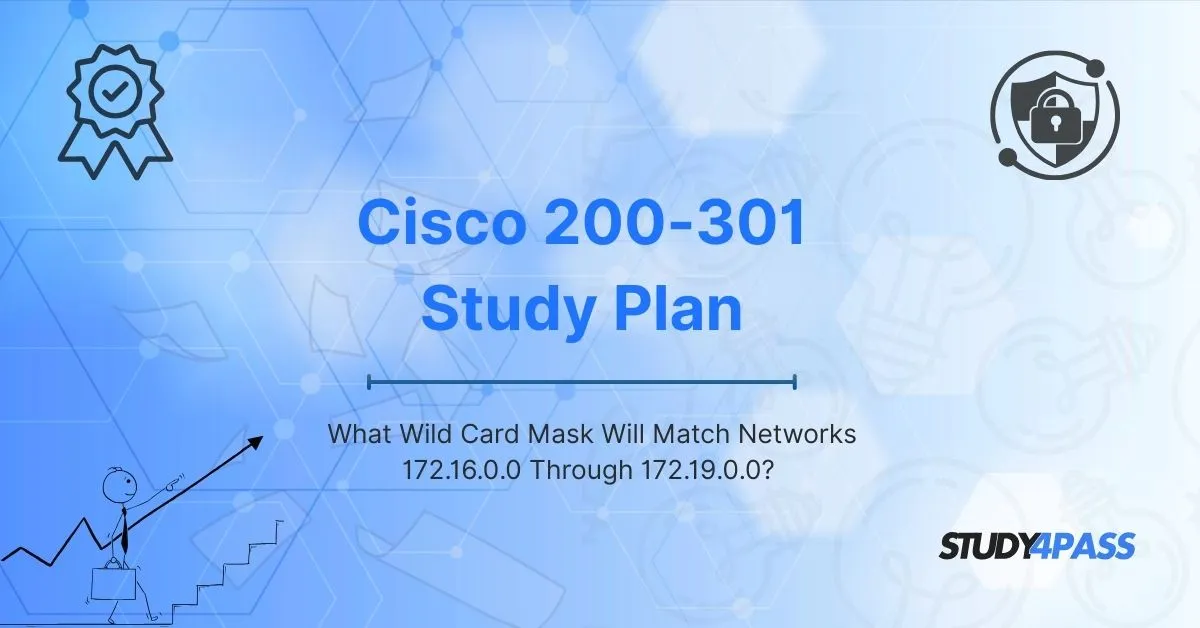Introduction To Cisco 200-301 Study plan
Preparing for the Cisco CCNA 200 301 exam requires a solid understanding of networking concepts, including wild card masks in Access Control Lists (ACLs). A common question that arises is:
What wild card mask will match networks 172.16.0.0 through 172.19.0.0?
In this comprehensive guide, we’ll break down the solution while integrating a structured Cisco 200-301 study plan to help you master this topic and ace your exam.
Understanding Wild Card Masks
Before solving the problem, let’s clarify what a wild card mask is and how it differs from a subnet mask.
1. What is a Wild Card Mask?
- Used in ACLs (Access Control Lists) and OSPF configurations.
- Determines which bits in an IP address must match (0 = must match, 1 = ignore).
- Example: A wild card mask of 0.0.0.255 means the first three octets must match, but the last octet can vary.
2. Wild Card Mask vs. Subnet Mask
- Subnet Mask Wild Card Mask
- Defines network and host portions (1s = network, 0s = host) Defines which bits to check (0s = check, 1s = ignore)
Example: 255.255.255.0 Example: 0.0.0.255
Solving the Problem: Matching 172.16.0.0 – 172.19.0.0
To match networks 172.16.0.0 through 172.19.0.0, we need a wild card mask that allows the third octet to range from 16 to 19 while keeping the rest fixed.
Step 1: Convert IP Ranges to Binary
Let’s analyze the third octet (since the first two octets are 172.* and the last is 0.0):
|
Network |
Third Octet (Decimal) |
Third Octet (Binary) |
|
172.16.0.0 |
16 |
0001 0000 |
|
172.17.0.0 |
17 |
0001 0001 |
|
172.18.0.0 |
18 |
0001 0010 |
|
172.19.0.0 |
19 |
0001 0011 |
Step 2: Find the Common Bits
- Looking at the binary, the first 4 bits (0001) remain the same, while the last 4 bits change.
- Fixed bits (must match): `0001` (first 4 bits)
- Variable bits (can change): `xxxx` (last 4 bits)
Step 3: Determine the Wild Card Mask
A 0 in the wild card mask means must match.
- A 1 means can vary.
- For the third octet:
- First 4 bits = must match (0)
- Last 4 bits = can vary (1)
- Thus, the wild card mask for the third octet is:
- `0000 1111` = 15 in decimal.
- Final Wild Card Mask
Since the first two octets (172.*) must match exactly, and the last octet (0.0) must also match:
- IP Address: `172.16.0.0`
- Wild Card Mask: `0.3.0.0`
Explanation:
- First Octet (172): `0` (must match exactly)
- Second Octet (16-19): `3` (binary `0000 0011`, allows variation in last 4 bits)
- Third & Fourth Octets (0.0): `0.0` (must match exactly)
Verification
- Let’s test if this wild card mask works:
- `172.16.0.0` & `0.3.0.0` → Matches 172.16.0.0 – 172.19.0.0
- `172.20.0.0` → Does not match (since 20 is `0001 0100`, differing beyond the mask).
- Cisco 200-301 Study Plan: Mastering Wild Card Masks
To ensure you fully grasp wild card masks for the CCNA 200-301 Certification, follow this structured study plan:
Week 1: Networking Fundamentals
- Review IPv4 addressing & subnetting.
- Practice converting decimal to binary.
- Understand ACLs and OSPF basics.
Week 2: Wild Card Mask Deep Dive
- Solve 10+ wild card mask problems (like the one above).
- Compare subnet masks vs. wild card masks.
- Use Cisco Packet Tracer to test ACL configurations.
Week 3: Practice & Labs
- Set up ACLs in a lab environment.
- Experiment with different wild card masks to see their effects.
- Take CCNA practice tests focusing on ACLs.
Week 4: Exam Readiness
- Review common CCNA wild card mask questions.
- Join study groups (like Study4Pass forums).
- Take full-length mock exams.
Conclusion
Understanding wild card masks is crucial for the Cisco 200-301 exam, especially for ACL configurations. By following the Cisco 200-301 study plan outlined here, you’ll gain confidence in tackling such questions.
Special Discount: Offer Valid For Limited Time “200-301 Exam Prep Practice Test”
Actual exam question from Cisco's 200-301 Exam.
Sample Questions for Cisco 200-301 Exam Prep Practice Tests
Which of the following should be included in an effective Cisco 200-301 study plan?
A. Memorizing all Cisco router models
B. Practicing subnetting, configuring devices, and reviewing exam objectives regularly
C. Skipping hands-on labs to save time
D. Focusing only on theory and avoiding practice exams


